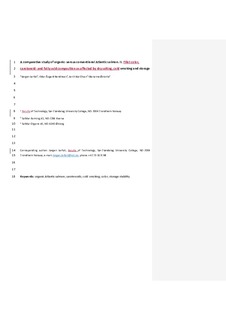| dc.contributor.author | Lerfall, Jørgen | |
| dc.contributor.author | Bendiksen, Eldar Åsgard | |
| dc.contributor.author | Olsen, Jan Vidar | |
| dc.contributor.author | Østerlie, Marianne | |
| dc.date.accessioned | 2018-01-02T08:19:27Z | |
| dc.date.available | 2018-01-02T08:19:27Z | |
| dc.date.created | 2015-11-26T13:03:16Z | |
| dc.date.issued | 2016 | |
| dc.identifier.citation | Aquaculture. 2016, 451 369-376. | nb_NO |
| dc.identifier.issn | 0044-8486 | |
| dc.identifier.uri | http://hdl.handle.net/11250/2473879 | |
| dc.description.abstract | The aim of the present study was to investigate the effect of dry salting, cold smoking and 14 days refrigerated storage at 4 °C on the stability of carotenoids, color and fatty acids in commercially reared organic Atlantic salmon (Salmo salar L.). As reference, conventionally reared Atlantic salmon was used. Pigment sources in feeds for the organic and conventional salmon were Panaferd-AX® (PAN) and Carophyll Pink® (CP), respectively. The dry salting process was found to be the main cause for losses of carotenoids throughout salting, smoking and storage, whereas no differences were found in stability of the different flesh carotenoids. The diverse composition of flesh carotenoids in organic salmon seems however to have minor influence on the color of the cold smoked product. Colorimetric characteristics of the fillet surface and liquid loss during storage of cold smoke fillets were found to be mostly affected by the fatty acid composition of the flesh which differed between the organic and conventional raw material. Moreover, dry salting and cold smoking were found to alter colorimetric differences between raw organically and conventionally reared salmon, resulting in an equal colorimetric perception of cold smoked organic and conventional salmon fillets after 14 days refrigerated vacuum storage.
Statement of relevance:
•This paper investigates the stability of carotenoids, color and fatty acids throughout processing and storage of cold smoked organic farmed Atlantic salmon.
•This paper focuses on the diversity of carotenoids presented in organic salmon fed a feed containing Panaferd-AX and how these carotenoids affect the color of the smoked product.
•This paper investigates the suitability of the presented organic salmon as raw material for the smoking industry. | nb_NO |
| dc.language.iso | eng | nb_NO |
| dc.publisher | Elsevier | nb_NO |
| dc.title | A comparative study of organic- versus conventional Atlantic salmon. II. Fillet color, carotenoid- and fatty acid composition as affected by dry salting, cold smoking and storage | nb_NO |
| dc.type | Journal article | nb_NO |
| dc.description.version | submittedVersion | nb_NO |
| dc.source.pagenumber | 369-376 | nb_NO |
| dc.source.volume | 451 | nb_NO |
| dc.source.journal | Aquaculture | nb_NO |
| dc.identifier.doi | 10.1016/j.aquaculture.2015.10.004 | |
| dc.identifier.cristin | 1293751 | |
| dc.description.localcode | This is a submitted manuscript of an article published by Elsevier Ltd in Aquaculture, 9 October 2015. | nb_NO |
| cristin.unitcode | 194,66,15,0 | |
| cristin.unitname | Institutt for bioteknologi og matvitenskap | |
| cristin.ispublished | true | |
| cristin.fulltext | preprint | |
| cristin.qualitycode | 1 | |
